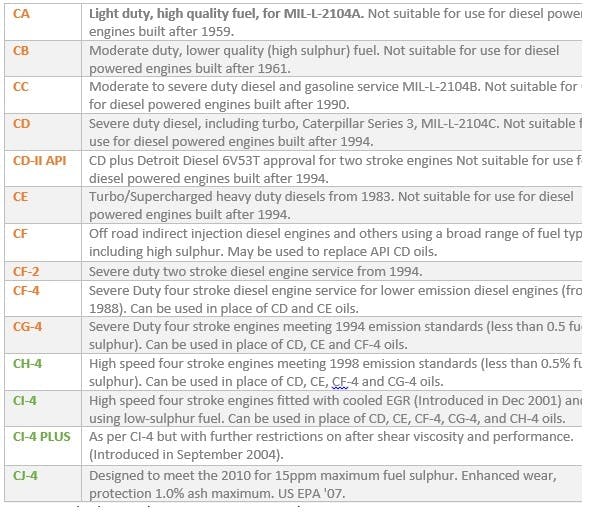Gasoline (or Petrol) Engine Service Classifications
The American Petroleum Institute, API, is a U.S.A trade association for the oil and natural gas industry. It reunites different actors in the production, refinement, distribution and many other activities around ptroleum. Amongst their activities, they set up diverse technical standards, such as measurement methods, standards for the design of pressure vessels, etc., but also industry standard for the energy conservation of the motor oil.There are two categories: gasoline and diesel. Category S is for “Spark Ignition”, for Gasoline and category C is for “Compression Ignition’, for Diesel. For both, the letter S or C is followed by another letter. For example, SM or CF. The higher the letter, the more recent the technology of the oil. For recent oil, the higher specification will supersede the lower letter grade. For example, if we have an oil with specification SN, it can also be used for vehicles which request API SM, SL and SJ; it is backward compatible.
However, you have to pay attention to the year of construction of the engine. If the engine is too old, modern chemistry might not be adapted or compatible with old engine designs and materials used to make the engine. Let’s see by category how it works.
Below are all the API categories in Gasoline. It
is mainly for passenger car, as most of the cars in US are Gasoline and not
Diesel.

Specifications from SA to SH are considered obsolete, meaning that you cannot get any official license from the API. It is meant for 1995 and older engines. As explained earlier, the higher the letter, the more recent and a higher specification would supersede the lower ones. API SN to SJ are for the most recent cars, API SH to SA for the older cars. Few examples to illustrate what would be the best:
- Example 1: Car from 1987 and you only have two available oils, one with API SH, the other one with SL. If you read the table properly, the car needs an API SF. In theory, both SH and SL could be used. As also explained earlier, more modern oils are not necessarily adapted for older engines. Therefore, the oil with SH level would be more adapted.
- Example 2: Car from 2003 and you have different oils available: API SJ, SM or SN. In this case, you need API SL, so an API SJ, lower, cannot be good. SM and SN supersedes SL so both oils can be used.
Generally speaking, the best would be to follow the recommendation of the table.
Diesel Engine Service Classifications
Below are all the categories in Diesel. It is mainly focused on heavy duty, meaning for trucks, buses, etc.

Orange: obsolete grades / Green: current grades.
As for the S category applies: the higher the letter, the more recent and it is backward compatible. There is a number after the letter, 2 or 4. It is for 2-stroke or 4-stroke engines.
The way the table works is exactly the same than for the C category. If you have a vehicle which was built after 1994, you should check in the categories from CD to CJ-4. For engines manufactured before 1994, preferably use oils in categories CA, CB and CC. If for example an engine requires an API CG-4 and you have only a CI-4 oil available, CI-4 will cover the needs of CG-4, as stated in the table.
If you want to have more details about API and their lubricant program, check there website.


